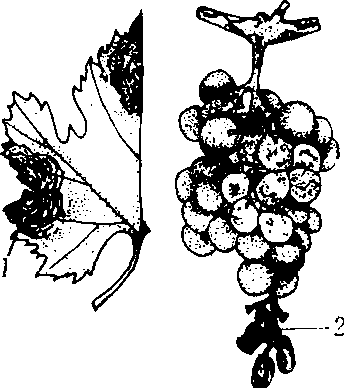葡萄白腐病grape white rot
由白腐盾壳霉为害葡萄果粒、穗轴、叶片和新梢的真菌病害。1878年首先在意大利发现,中国1899年最早报道。
分布和为害 全球分布,以欧洲常降冰雹地区损失最大。目前为中国北方葡萄产区的严重病害,可使果实腐烂、成串掉落。华北黄河故道及陕西关中经常发生,病害流行年份,如不进行防治,损失可达60%。
果穗受害,症状最典型。果穗成熟前,病果粒略带黄色,外观不饱满,病菌分生孢子器使寄主表皮层隆起,但不破裂,病果粒苍白色。成熟的分生孢子器灰白色,病果粒最终脱落。高温高湿环境,病菌自病粒经果梗蔓延至穗轴,破坏果穗。果梗发病最初呈青褐色长形细小病斑,如温湿度适宜,蔓延整个果梗。穗轴发病,病斑下面的果穗很快干枯。病菌侵染前如果粒已干,不形成分生孢子器。尚未木质化的新梢受害形成溃疡斑,溃疡梢遇大风易折断。叶片受害,多在叶缘产生浅褐色大型病斑,有不明显轮纹,病斑上局部散生灰白色小点。以后病组织干枯破裂,病叶破损。
病因 病原物为白腐亚球腔菌[Coniothyriumdiplodiella(Speq.)Saee.],属子囊菌,座囊菌目,中国尚未发现。无性态为白腐垫壳孢,属半知菌、球壳孢目。分生孢子器自角质层下的子座长出,褐色、球形,具孔口,底部的产孢区垫状,一般无分生孢子梗,产孢细胞瓶梗型,分生孢子榄褐色或榄色,单胞、卵圆形,顶端钝,基部平截。
侵染过程和病害循环 病菌生活史有寄生阶段(较短)和在土壤内休眠阶段(较长)。生长季节的后期,病果粒、穗轴和新梢脱落,病菌在土壤内进入休眠期。分生孢子器释放的大量分生孢子可存活2~3年。干的分生孢子器经15年仍可释放活的分生孢子。病菌多分布于1米深度以内的土层,土表至20厘米处最多,约占总菌量80%。夏季降雨,带菌土粒飞溅到果穗,引起初侵染,冰雹和果园操作也起类似作用。病菌不侵染无伤口的果穗,冰雹造成的破伤最易引起侵染,但病菌可直接侵入穗轴和果梗。分生孢子在破伤果粒汁液中,或在渗有果粒渗出物的雨滴中经数小时(24~27℃)即可萌发并开始侵染,15℃以下侵染很慢,超过34℃,病害发生轻微。潜育期3~8天,如侵染新梢,需时较长。夏天暴雨后接着持续高湿,相对湿度95%以上和24~28℃的高温,是病害流行的主要因素。如遇冰雹引起大量伤口病害尤其严重。中国北方果园,通常七八月雨季是病害大发生时期。其他国家植株生长初期雨水较多而后期雨水少,病害较轻,幼果粒较后期果粒抗病。
病害控制 防治白腐病的主要措施是: 夏天高温多雨或冰雹之后及时喷布退菌特、福美双、百菌清或克菌丹;及时摘除最早出现的病穗,减少病菌的再侵染;由于初侵染源来自土壤,修剪时适当提高结果部位,使果穗不靠近地面,减少病菌侵染机会;采收、落叶和修剪后应立即清园;及时除草、绑蔓、摘副梢,使枝叶果穗之间通风透光,不利于病菌的蔓延而有利于喷药保护。
葡萄白腐病grapevine white rot
又称水烂病、腐烂病。葡萄的重要真菌病害。病原菌是半知菌亚门的白腐盾壳霉〔Co-niothyrium diplodiella (Speq.)Sacc.〕。主要分布于中国北方和黄河故道地区。危害果穗、新梢及叶片。病菌多从近地面处的果梗或穗轴的伤口侵入,逐渐扩展到果粒,导致整个果粒变褐腐烂,病果皮上密生灰白色微粒(分生孢子器),烂果粒易脱落。后期果梗穗轴干枯,未脱落的烂果失水干缩成棱角僵果。新梢及叶片受侵染后出现梢枯和具环纹的叶斑,枝蔓皮层纵裂呈麻丝状与木质部分离。病菌以菌丝体或分生孢子器随落果或残体在地面或土中越冬,在土中可存活数年。高温多雨有利于发病,果实接近成熟期进入发病高峰,产量损失严重。宜采取以地面撒药及喷药保护相结合的防治措施。

葡萄白腐病
1.病叶 2.病果